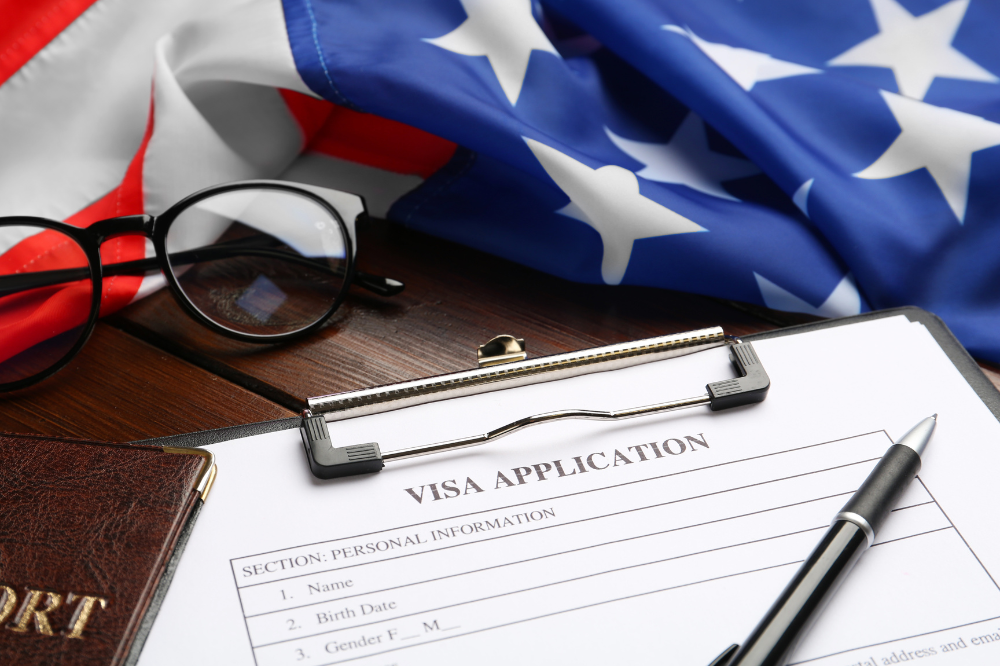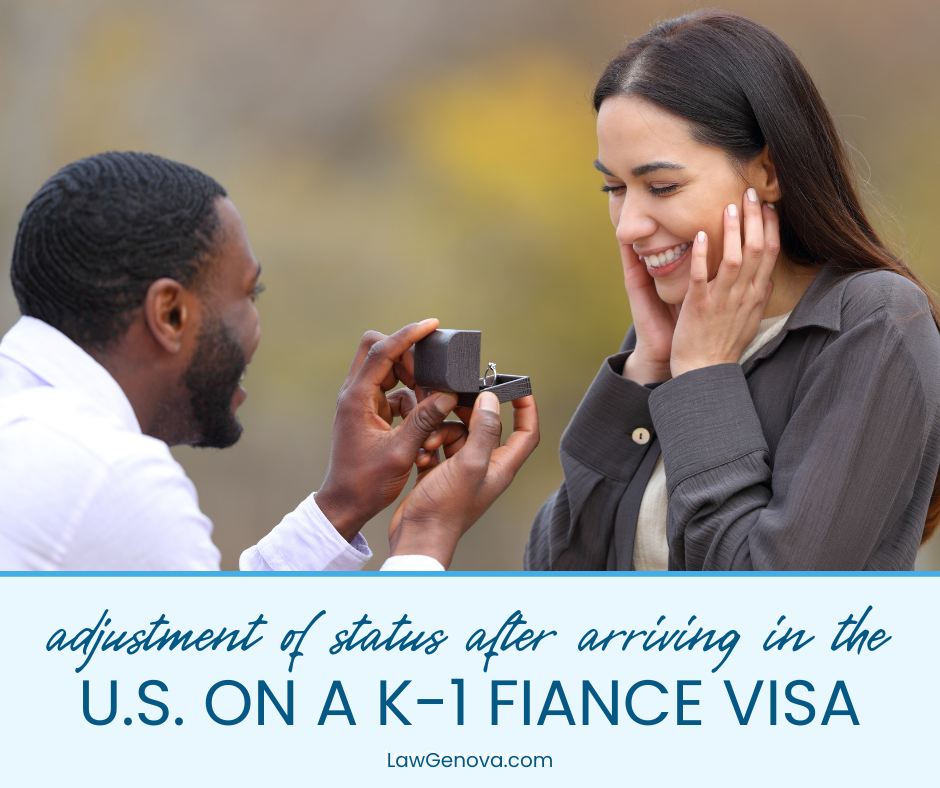When you’re a U.S. citizen who wants to marry someone from another country – whether it’s your country of origin or elsewhere – you may be able to bring your fiancé to the United States on a K-1 visa. The K-1 visa is designed to allow a U.S. citizen and their foreign fiancé to get married in the United States, but there are very strict limitations on it (learn more about the limitations in the later section, “Limitations on the K-1 Fiancé Visa”). After your fiancé arrives and you marry each other, you can adjust your new spouse’s status to get them a green card, which this guide explains.
What is a K-1 Visa, and Can You Adjust Status to Get a Green Card if You Have One?
The K-1 visa is a nonimmigrant visa for a foreign fiancé of a U.S. citizen. The visa allows the foreign national to enter the United States for the purpose of getting married to their U.S. Citizen fiancé within 90 days of arrival. After getting married, the U.S. citizen may apply for their spouse to get a green card. A green card is proof that someone’s a lawful permanent resident of the United States, and it enables that person to live and work anywhere in the country without any special authorization from the government.
Who Qualifies for a K-1 Visa?
In order for your fiancé to qualify for a K-1 visa, both the U.S. citizen and the foreign fiancé must meet several requirements.
The U.S. citizen petitioner must:
- Have been born in the United States or naturalized through the process of becoming a U.S. Citizen
- Be at least 18 years old
- Intend to marry their foreign fiancé within 90 days of their arrival in the United States
- Meet in person with their foreign fiancé at least once within the two years prior to filing the K-1 visa petition
- Be able to financially support their fiancé during their time in the United States
The foreign fiancé must:
- Be legally free to marry, meaning that they’re not currently married and any previous marriages have ended through divorce, annulment, or death
- Intend to marry their U.S. citizen petitioner within 90 days of arrival in the United States
- Pass a medical examination conducted by a U.S. government-approved doctor
- Prove that they have enough financial resources to support themselves during their time in the United States (which may be through their sponsor)
Your immigration attorney can explain any other requirements either of you must meet.

Adjustment of Status After a K-1 Visa
After your foreign fiancé enters the United States on a K-1 visa and you get married, you can apply for a green card through a process known as adjustment of status. Essentially, this process changes the person’s immigration status from a K-1 visa holder to a conditional green card holder. (See the later section, “Why Do K-1 Immigrants Get a Conditional Green Card?” for more information on the conditions associated with lawful permanent residency for newlyweds.)
To adjust your new spouse’s status, your attorney will file Form I-485, Application to Register Permanent Residence or Adjust Status with USCIS. You should include the following supporting documents with your application:
- Your marriage certificate
- Proof that you’re a U.S. citizen, such as a copy of your birth certificate or passport
- Your new spouse’s birth certificate
- Proof that you remain married, such as joint bank account statements and/or lease agreements
- Your new spouse’s police clearances from any country they have lived in for more than six months since the age of 16
- Evidence that you can financially support your new spouse, such as your most recent tax return
You’ll also need to attend an interview at a USCIS office, during which a USCIS officer will ask you questions about your relationship and marriage. If the officer is satisfied that your marriage is bona fide (legitimate), they’ll approve your application and your spouse will receive their conditional green card in the mail.
Related: Everything you need to know about green card marriage
Special Circumstances
There are a few special circumstances that can complicate the adjustment of status process for K-1 visa holders. These include:
- Bars to adjustment of status. There are certain circumstances that can prevent someone from adjusting their status; they’re called bars to adjustment. For example, if your spouse previously entered the United States on a visa but overstayed, or if they previously violated U.S. immigration law, you may not be able to adjust their status. (You can check out a list of bars to adjustment here.)
- Grounds of inadmissibility. There are also certain grounds of inadmissibility that can make someone ineligible for a green card. For example, if your spouse has a communicable disease “of public health significance” or has committed a crime of moral turpitude in the past, they may not be admissible to the U.S. – though some people are eligible for waivers. If your spouse may be ineligible to adjust status, you should talk to your attorney to find out whether you have any options. (A crime of moral turpitude is a crime that’s considered to be morally reprehensible, such as murder, rape or child abuse.)
Related: Getting a green card with a criminal record
How Do You Apply for a K-1 Visa to Get the Green Card Process Started?
The first step in applying for a K-1 visa is for the U.S. citizen sponsor’s attorney to file Form I-129F, Petition for Alien Fiancé with USCIS. This form establishes that the sponsor and beneficiary are free to marry, that they have met in person within the past two years, and that they intend to marry within 90 days of the beneficiary’s arrival in the United States.
After USCIS approves the petition, it will be forwarded to the National Visa Center (NVC), which will then forward it to the U.S. embassy or consulate where the beneficiary is located. The beneficiary will then need to complete the following steps:
- Submit a visa application: The first step is to complete and submit a visa application, which can be done online through the State Department’s website.
- Pay the visa application fee: The second step is to pay the visa application fee.
- Submit additional documents: The third step is to submit additional documents, which may include evidence of the relationship, police clearances, and financial documents.
- Attend an interview: The fourth and final step is to attend an immigration interview at the U.S. embassy or consulate. During the interview, a consular officer will ask the beneficiary questions about the information on the application, as well as questions about the beneficiary’s relationship with the U.S. citizen. If they’re satisfied that your relationship is bona fide and that the beneficiary meets all the other requirements, they’ll approve the visa application.
After you have your K-1 visa, you can travel to the United States. After your arrival, you have 90 days to marry your U.S. citizen sponsor. Once you’re married, you can apply for a green card through the adjustment of status process.
Can Your Fiancé’s Family Members Come to the U.S. With Them on a K-1 Visa?
If your fiancé has children, they may be eligible to come to the United States on a K-2 visa. The K-2 visa is for children of K-1 visa holders who are under 21 years of age and unmarried. Older sons and daughters don’t qualify.
Documents You Need to Apply for a Green Card if You Came to the U.S. on a K-1 Visa
If you came to the United States on a K-1 visa, you’ll need to submit the following documents when you apply for a green card:
- Application for Permanent Residence (Form I-485): You need Form I-485, Application to Register Permanent Residence or Adjust Status, which your attorney can do for you.
- Proof of relationship: You must submit proof of your relationship to your U.S. citizen spouse, which can include photographs, joint bank statements or birth certificates for children you have together. Your New York immigration attorney can give you specific guidance on the types of documentation you may need to provide.
- Proof of financial support: You’ll most likely need to show that you have enough financial support to live in the United States. This can be done with your sponsor’s bank statements, pay stubs or tax returns.

Why Do K-1 Nonimmigrants Get a Conditional Green Card?
All K-1 visa holders receive a conditional green card, which is valid for two years. The conditions on the green card must be removed within those two years or the card will expire and you’ll be required to leave the United States.
The purpose of the conditional green card is to ensure that people don’t simply get married to obtain an immigration benefit. The conditions attached to the green card is that you remain married to the same person who made you initially eligible for the green card – and that your marriage is genuine. That means you married because you wanted to be married to each other – not simply so that you could get a green card. (It’s illegal to marry someone simply to receive an immigration benefit, and if you’re caught doing so, you’ll be removed from the U.S. and be forbidden from coming back for a certain period of time.)
Removing Conditions From a Green Card You Obtained as a K-1 Visa Holder
To remove the conditions on your green card, you’ll need to file Form I-751, Petition to Remove Conditions on Residence, with USCIS within the 90 days before your green card expires. You cannot remove the conditions before that time.
You’ll need to submit evidence that you’re still married and living together with your spouse, as well as proof of any joint income or assets, such as joint bank statements or tax returns. You may also need to provide evidence of your good moral character, such as police clearances, and proof that you have not abandoned your residence in the United States.
Do You Need to Talk to an Immigration Attorney About Adjustment of Status After Having a K-1 Visa?
If you need to talk to an immigration attorney, we may be able to help you. Call our office at 914-481-8822 to schedule a consultation with an experienced, knowledgeable immigration attorney who can answer your questions and give you the legal advice you need.


